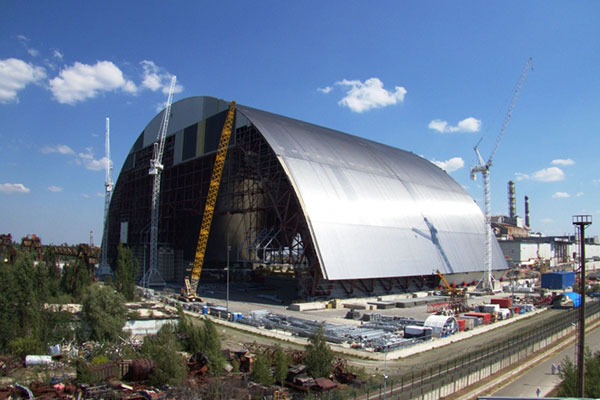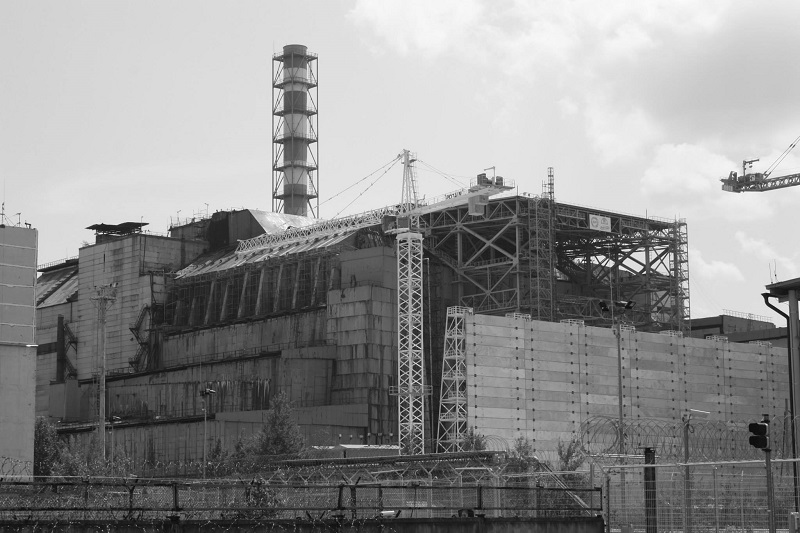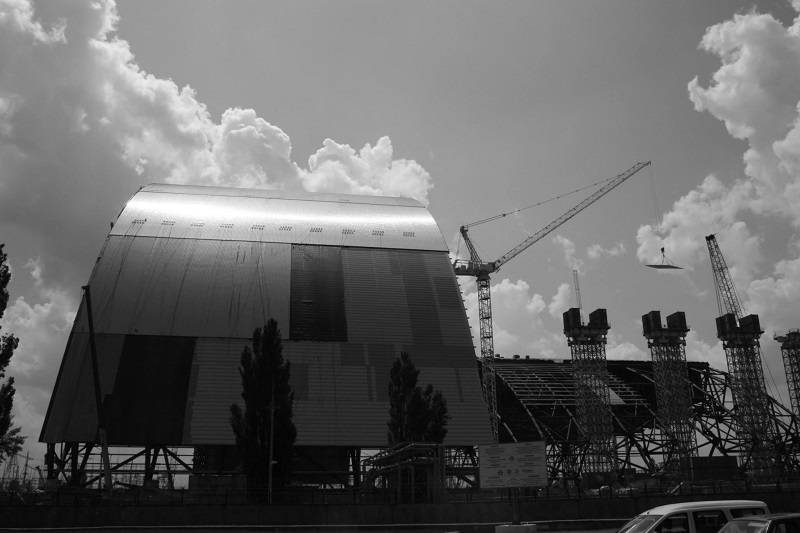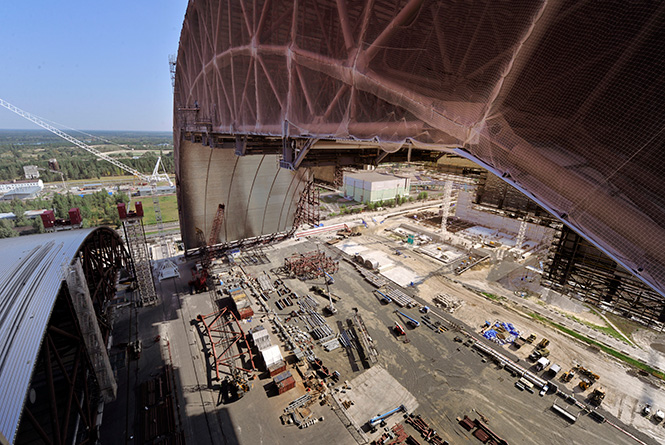Chernobyl New Safe Confinement
(Image courtesy of Novarka)
Contents |
[edit] Introduction
The Chernobyl disaster of 26 April 1986, when power plant reactor No.4 exploded, was the deadliest nuclear accident in history.
The explosion expelled the equivalent of 100 times the combined radiation of the atomic bombs dropped on Hiroshima and Nagasaki in 1945. The westerly winds propelled the fallout across mainland Europe and into Sweden, Italy, Germany, the South of France, and even Great Britain.
Just over thirty years on, in November 2016, the long-awaited structure known as 'New Safe Confinement' (NSC) was moved into position in what has been described as a ‘historic engineering achievement’.
The arch-shaped NSC is thought to be the largest land-based moving structure in the world. It weighs 36,000-tonnes, and at 108 m in height, 162 m in length, and 257 m span, is large enough to enclose the Statue of Liberty or the footprint of the Eiffel Tower. The NSC is intended to contain the nuclear reactor and the radioactive remains for the next 100 years.
The NSC is the major part of the Shelter Implementation Plan which is being undertaken by Novarka, a 50/50 joint venture between Vinci Construction and Bouygues Travaux Publics. Completion is expected by the end of 2017, at an estimated final cost of €2.15 billion (of which, the NSC accounts for €1.5 billion).
[edit] Existing structure
(Sarcophagus. Photograph by Michael Brooks)
To contain the fallout immediately after the disaster, the Soviet Union mobilised an estimated 500,000 workers to build the Shelter Object, or sarcophagus, which enclosed the ruins of the nuclear reactor.
The sarcophagus consisted of more than 7,700 tonnes of metal and 400,000 cubic metres of concrete, but it was only intended as a temporary solution, and over the decades, it has been falling into disrepair.
The NSC is designed to stabilise and secure the reactor ruins as well as the sarcophagus. The intention is for the sarcophagus to be protected from weather damage and to enable work to begin on deconstructing the reactor.
[edit] Design
In 1992, the Ukrainian government held an international competition for design concepts to replace the sarcophagus. The British firm Design Group Partnership were the only one of 394 entries to propose a sliding arch. While the submission did not win, it was largely adopted as the design solution.
Positioned on two longitudinal concrete beams, the steel lattice structure consists of 13 arches 12.5 m (41 ft) apart to form 12 bays. The ends of the structure are sealed by vertical walls that are assembled around, but not supported by, the existing structures of the reactor.
The arches are clad with 86,000 sq. m of three-layer sandwich panels. The inside of each arch is covered with polycarbonate to prevent radioactive particles accumulating on the frame members, causing them to rust.
In the space between the inner and outer skins, dried air will be circulated, while being depressurised to prevent dust escaping.
The structure is designed to resist fire and freezing winter temperatures, as well as being able to withstand an earthquake or tornado of more than 200 mph.
[edit] Construction process
(Photograph by Michael Brooks)
The arch was assembled 180 m (590 ft) from the damaged reactor and slid into place above the existing sarcophagus using rail tracks mounted on the concrete foundation.
During the peak construction period, 1,200 Ukrainian operatives were on site, with 60 dedicated radio-protection professionals. The radiation and atmospheric pollution was constantly monitored, and all workers fitted with appropriate personal protective equipment (PPE) and two dosimeters.
The construction process was broadly as follows:
- Stabilisation of the sarcophagus to prevent collapse; cleaning and clearing the assembly area.
- Two wide trenches excavated on either side of the reactor for the longitudinal beams to serve as arch foundations.
- Solid blocks built in the centre to support the towers required for lifting and assembly of the NSC.
- Metal piles of 1 m diameter were driven to an average depth of 25 m in the trenches.
- Construction of the first half of the arch began with preassembly of the upper section. Bracing was used to interconnect the segments before fitting the cladding on the central section.
- Secondary arch elements were connected to the central section using a hinge system.
- The towers were used to lift the arch and remaining components added to the lower sections and feet.
- Pushing equipment was installed to slide the completed first-half into the holding area.
- The second half of the arch was assembled in the same way.
- The two halves were connected together, and bracing and metal cladding connections completed.
- Overhead bridge cranes were fixed to the arch for dismantling the existing sarcophagus and reactor ruins.
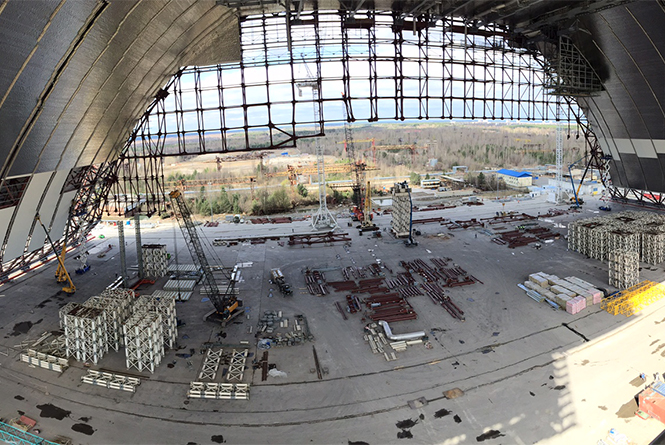 (Photograph courtesy of Novarka.)
(Photograph courtesy of Novarka.)
[edit] Sliding into position
After testing was completed, the NSC was moved into position. The sliding was achieved with the help of a special skidding system consisting of 224 hydraulic jacks that pushed the arch at a rate of 60 cm each stroke. The process took five days.
Once in position, the side walls will be connected to the existing structures, isolating the damaged reactor permanently.
(Photograph courtesy of Novarka.)
[edit] Solar plant
Also in November 2016, it was announced that the Chinese clean energy company Golden Concord Holdings Ltd (GCL) will build a 1GW solar photovoltaic power plant in the 30 km ‘Exclusion Zone’ around the nuclear plant.
The general contractor for the project will be the state-owned China National Complete Engineering Corporation (CCEC). Construction is scheduled to begin in 2017.
Mr. Shu Hua, Chairman of GCL said: “There will be remarkable social benefits and economical ones as we try to renovate the once damaged area with green and renewable energy. We are glad that we are making joint efforts with Ukraine to rebuild the community for the local people.”
[edit] Find out more
[edit] Related articles on Designing Buildings Wiki
Featured articles and news
Delivering for tenants; National Retrofit Hub
New report offers recommendations to strengthen energy efficiency standards to protect private renters.
Government consultations for the summer of 2025
A year of Labour, past and present consultations on the environment, the built environment, training and tax.
CMA competitiveness probe of major housing developers
100 million affordable housing contributions committed with further consultation published.
Homes England supports Greencore Homes
42 new build affordable sustainable homes in Oxfordshire.
Zero carbon social housing: unlocking brownfield potential
Seven ZEDpod strategies for brownfield housing success.
CIOB report; a blueprint for SDGs and the built environment
Pairing the Sustainable Development Goals with projects.
Types, tests, standards and fires relating to external cladding
Brief descriptions with an extensive list of fires for review.
Latest Build UK Building Safety Regime explainer published
Key elements in one short, now updated document.
UKGBC launch the UK Climate Resilience Roadmap
First guidance of its kind on direct climate impacts for the built environment and how it can adapt.
CLC Health, Safety and Wellbeing Strategy 2025
Launched by the Minister for Industry to look at fatalities on site, improving mental health and other issues.
One of the most impressive Victorian architects. Book review.
Common Assessment Standard now with building safety
New CAS update now includes mandatory building safety questions.
RTPI leader to become new CIOB Chief Executive Officer
Dr Victoria Hills MRTPI, FICE to take over after Caroline Gumble’s departure.
Social and affordable housing, a long term plan for delivery
The “Delivering a Decade of Renewal for Social and Affordable Housing” strategy sets out future path.
A change to adoptive architecture
Effects of global weather warming on architectural detailing, material choice and human interaction.
The proposed publicly owned and backed subsidiary of Homes England, to facilitate new homes.
How big is the problem and what can we do to mitigate the effects?
Overheating guidance and tools for building designers
A number of cool guides to help with the heat.
The UK's Modern Industrial Strategy: A 10 year plan
Previous consultation criticism, current key elements and general support with some persisting reservations.
Building Safety Regulator reforms
New roles, new staff and a new fast track service pave the way for a single construction regulator.






